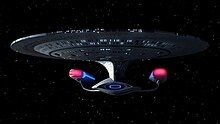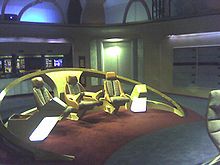USS Enterprise (NCC-1701-D)
| USS Enterprise | |
|---|---|
 The USS Enterprise (NCC-1701-D) | |
| First appearance | "Encounter at Farpoint" |
| Last appearance | Star Trek Generations (continuity) "These Are the Voyages..." (airdate) |
| Information | |
| Affiliation | United Federation of Planets Starfleet |
| Launched | October 4, 2363 |
| General characteristics | |
| Class | Galaxy |
| Registry | NCC-1701-D |
| Armaments | Phasers Photon torpedoes |
| Defenses | Deflector shields |
| Propulsion | Impulse engines Warp drive RCS Thrusters |
| Length | 642.5 Meters |
| Width | 467.0 Meters |
| Height | 137.5 Meters |
The USS Enterprise (NCC-1701-D) (or Enterprise-D, to distinguish it from prior starships with the same name) is a 24th century starship in the Star Trek fictional universe and the principal setting of the Star Trek: The Next Generation television series.[1] The Enterprise-D is a Galaxy-class ship and the fifth Federation starship to carry the name Enterprise [2]
The Enterprise-D also appears in the pilot episode of Star Trek: Deep Space Nine ("Emissary"),[2] the series finale of Star Trek: Enterprise ("These Are the Voyages..."), and in the feature film Star Trek Generations, where the ship crashes on Veridian III in her last appearance.[2]
Design
Andrew Probert, who assisted in updating the original Enterprise for Star Trek: The Motion Picture, designed the Enterprise-D.[2] Originally tasked with designing the bridge, Probert had a "what if" sketch hanging on his wall that he had drawn after working on The Motion Picture. Story editor David Gerrold saw the sketch and brought it to creator Gene Roddenberry's attention, who approved the sketch as a starting point for the Enterprise-D's design.
An Industrial Light & Magic team supervised by Ease Owyeung built two filming miniatures (a six-foot model and a two-foot model) for "Encounter at Farpoint", the Star Trek: The Next Generation pilot, and these models were used throughout the first two seasons.[3] For the third season, model-maker Greg Jein built a four-foot miniature, which had an added layer of surface plating detail.[3] The six-foot model was used whenever a saucer separation sequence needed to be filmed, and was then updated by ILM for use in Star Trek Generations[citation needed]. In October 2006, the six-foot Enterprise shooting miniature was auctioned in New York City at Christie's auction house, along with other models, props, costumes, and set pieces from the Star Trek franchise. Its projected value was $20,000 to $30,000, but the final sale price was $576,000. It was the most expensive item in the auction.[4]
ILM's John Knoll also built a CGI Electric Image model of the Enterprise-D for the 1994 film Star Trek Generations.[2] That model was transferred to LightWave and used to create various Galaxy-class starships in episodes of Star Trek: Deep Space Nine and in the Star Trek: Voyager episode "Timeless".[citation needed]
Eden FX's Gabriel Köerner built a new CGI LightWave model for the Enterprise-D's appearance in Star Trek: Enterprise's series finale, "These Are the Voyages...".[citation needed]
The proportions of the Galaxy-class Enterprise-D were different from the original Enterprise while retaining its familiar dual warp nacelles and saucer section appearance. The warp nacelles were made proportionally smaller than the saucer section based on the idea that warp engines would have become more efficient over time.
It was created as a toy by Playmates in 1992 and by Art Asylum in 2009.
Depiction
The Enterprise-D is first seen in "Encounter at Farpoint" under the command of Captain Jean-Luc Picard. Several episodes, as well as the ship's dedication plaque, establish that the Enterprise was built at the Utopia Planitia Fleet Yards around Mars.[3] The Enterprise-D is the third Galaxy-class starship, after the pathfinder ship USS Galaxy (from which the Galaxy-class takes its name) and the USS Yamato.[3] The dedication plaque gives its commissioning date as 40759.5, which was intended to represent October 4, 2363.[3]
Throughout the course of Star Trek: The Next Generation, the ship's crew makes first contact with multiple species, including the Borg in "Q Who?" (although technically Captain Archer and his crew are the first humans to deal with the Borg, many years earlier) and the Q Continuum in "Encounter at Farpoint".[2] The Enterprise-D is instrumental in the defeat of the Borg during their 2366 attempt to invade the Federation in "The Best of Both Worlds, Part II".

In 2371, as depicted in Star Trek Generations, the Klingon Duras sisters obtain the phase modulation frequency of the Enterprise-D's shields, rendering them useless.[2] Although the Enterprise-D destroys the sisters' ship, damage to the warp drive coolant system prompts an emergency saucer separation.[2] The warp core breaches moments after the saucer begins to move away, destroying the ship's stardrive section.[2] The resulting shockwave impacts the saucer, disabling propulsion and other primary systems, sending it into Veridian III's atmosphere.[2] Caught in the planet's gravity, the saucer section crash-lands on the surface, damaged beyond repair.[2] It was replaced by the Enterprise-E, which was introduced in the film Star Trek: First Contact.
According to commentary on the Star Trek Generations DVD, one of the real world reasons for the Enterprise-D's destruction stems from a concept drawing of a saucer section landing, produced for the Star Trek: The Next Generation Technical Manual. TNG writers Ronald D. Moore, Jeri Taylor, and Brannon Braga saw the drawing and wanted to use a saucer crash as a sixth-season cliffhanger episode for the series, but were unable to do so because of a limited budget and resistance from producer Michael Piller.[citation needed]
Alternate future
In the alternate future featured in the TNG series finale "All Good Things...", the Enterprise-D is intact in 2395.[2] In this alternate future, the ship is decommissioned and becomes the personal flagship of Admiral William Riker and has undergone major refits, including the addition of a third warp nacelle, new weapons, and a cloaking device.[2] This future timeline arises from a temporal anomaly that Picard, with Q's help, manages to eliminate.[2]
Saucer separation
The Galaxy-class Enterprise is capable of saucer separation and subsequent re-docking, used sometimes for leaving the civilian population behind when the stardrive section goes into combat,[3] as seen in the The Next Generation episodes "Encounter at Farpoint",[5] and "The Arsenal of Freedom",[6] for the additional combat advantage of having two separate vessels instead of one, as seen in "The Best of Both Worlds, Part II",[7] or as a lifeboat[3] as seen in the film Star Trek Generations.[8] The Enterprise was the only starship seen in any of the television series to perform saucer separation until the USS Prometheus during the fourth season of Star Trek: Voyager.
Command

The main bridge of the Galaxy-class Enterprise is located on deck 1. Three distinct Galaxy-class bridge variants have been seen: the Enterprise bridge in The Next Generation (which undergoes a redesign in the first two seasons), the Enterprise bridge in Star Trek Generations,[8] and the USS Odyssey bridge in the Star Trek: Deep Space Nine episode "The Jem'Hadar".[9] The Galaxy-class Enterprise also has a secondary battle bridge on deck eight of the secondary hull for use when the ship has undergone a saucer separation. It is first seen in the TNG episode "Encounter at Farpoint" and again in "The Arsenal of Freedom", with an updated version appearing in "The Best of Both Worlds".
Science and research

The Galaxy-class Enterprise supports an array of scientific disciplines, with laboratories and departments devoted to stellar cartography, exobiology, cetology, astrophysics, cybernetics, archaeology, cultural anthropology, botany, hydroponics, and planetary geosciences.[3]
Tactical
The Galaxy-class Enterprise is armed with twelve Type X phaser arrays and three photon torpedo launchers, each capable of firing ten individual torpedoes at a time.[3] One phaser array is mounted on the "cobra head" of the secondary hull while a photon torpedo launcher is mounted on the ventral aft of the saucer; both are inoperative while the saucer and stardrive sections are docked.[3] The ship also has a high capacity shield grid[3] and, according to dialogue in the Next Generation episode "Conundrum",[10] at least 250 photon torpedoes.
Transportation

The Galaxy-class Enterprise has at least six transporter rooms and twenty transporter systems. The ship has one large main shuttlebay in the saucer section, supported by two smaller bays in the stardrive section. The ship carries a variety of shuttlecraft and a captain's yacht.[3]
Medical and life support systems
The Galaxy-class Enterprise includes a sickbay and a number of labs and other medical facilities.[3] The shuttlebays, cargo bays, and other areas of the ship can be converted into triage wards;[3] such conversion of a cargo bay appears in the TNG episode "Ethics".[11] Other areas, such as Ten-Forward, can serve as emergency shelters.[3] Such use of Ten-Forward occurs in the Next Generation episode "Disaster".[12]
Crew support

Various Next Generation episodes show that the Galaxy-class Enterprise has amenities such as holodecks,[5] an arboretum, a school,[13] a gymnasium,[14] amphitheaters,[15] and a bar called Ten-Forward.[16] According to "Encounter at Farpoint",[5] several Enterprise crewmembers' civilian family members (including children) are aboard despite the fact that the Enterprise routinely faces situations that could easily end with the complete destruction of the ship with all hands. Some civilians work aboard the ship, such as the bartender Ben in "Lower Decks"[17] and botanist Keiko O'Brien in "Rascals"[18] and other episodes.
References
- ^ Nemeck, Larry (2003). Star Trek: The Next Generation Companion. Pocket Books. ISBN 0-7434-5798-6.
- ^ a b c d e f g h i j k l m n Okuda, Mike and Denise Okuda, with Debbie Mirek (1999). The Star Trek Encyclopedia. Pocket Books. ISBN 0-671-53609-5.
{{cite book}}: CS1 maint: multiple names: authors list (link) - ^ a b c d e f g h i j k l m n o Okuda, Michael and Rick Sternbach (1991). Star Trek: The Next Generation Technical Manual. Pocket Books. ISBN 0-671-70427-3.
- ^ "Christie's underestimates Trekkies, pulls $7.1 million". 2007-05-09. Retrieved 2007-06-09.
- ^ a b c "Encounter at Farpoint". Star Trek: The Next Generation.
{{cite episode}}: Unknown parameter|episodelink=ignored (|episode-link=suggested) (help) - ^ "The Arsenal of Freedom". Star Trek: The Next Generation.
{{cite episode}}: Unknown parameter|episodelink=ignored (|episode-link=suggested) (help) - ^ "The Best of Both Worlds, Part II". Star Trek: The Next Generation.
{{cite episode}}: Unknown parameter|episodelink=ignored (|episode-link=suggested) (help), - ^ a b Star Trek Generations, (1994)
- ^ "The Jem'Hadar". Star Trek: Deep Space Nine.
{{cite episode}}: Unknown parameter|episodelink=ignored (|episode-link=suggested) (help) - ^ "Conundrum". Star Trek: The Next Generation.
{{cite episode}}: Unknown parameter|episodelink=ignored (|episode-link=suggested) (help) - ^ "Ethics". Star Trek: The Next Generation.
{{cite episode}}: Unknown parameter|episodelink=ignored (|episode-link=suggested) (help) - ^ "Disaster". Star Trek: The Next Generation.
{{cite episode}}: Unknown parameter|episodelink=ignored (|episode-link=suggested) (help) - ^ "The Offspring". Star Trek: The Next Generation.
{{cite episode}}: Unknown parameter|episodelink=ignored (|episode-link=suggested) (help) - ^ "We'll Always Have Paris". Star Trek: The Next Generation.
{{cite episode}}: Unknown parameter|episodelink=ignored (|episode-link=suggested) (help) - ^ "Sarek". Star Trek: The Next Generation.
{{cite episode}}: Unknown parameter|episodelink=ignored (|episode-link=suggested) (help) - ^ "The Child". Star Trek: The Next Generation.
{{cite episode}}: Unknown parameter|episodelink=ignored (|episode-link=suggested) (help) - ^ "Lower Decks". Star Trek: The Next Generation.
{{cite episode}}: Unknown parameter|episodelink=ignored (|episode-link=suggested) (help) - ^ "Rascals". Star Trek: The Next Generation.
{{cite episode}}: Unknown parameter|episodelink=ignored (|episode-link=suggested) (help)
- Drexler, Doug; & Sternbach, Rick; & Zimmerman, Herman (1998). Star Trek: Deep Space Nine Technical Manual. Pocket Books. ISBN 0-671-01563-X.
- Lebowitz, Adam; & Bonchune, Robert (2001). Star Trek Starship Spotter. Pocket Books. ISBN 0-7434-3725-X.

